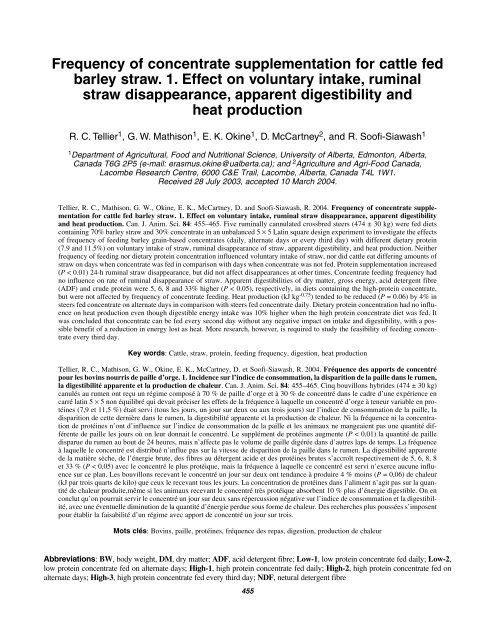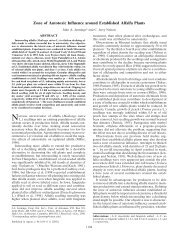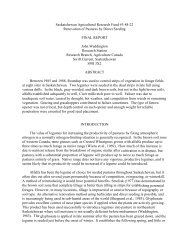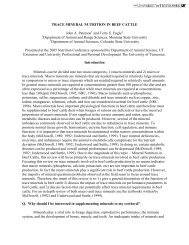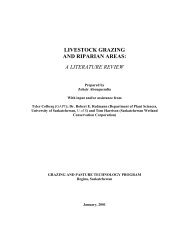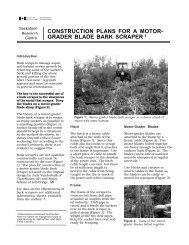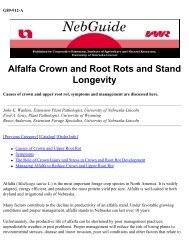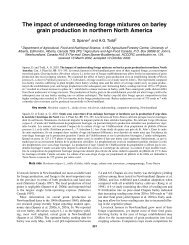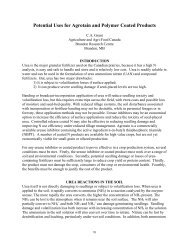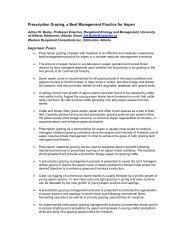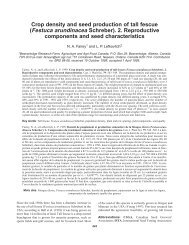Frequency of concentrate supplementation for cattle fed barley straw ...
Frequency of concentrate supplementation for cattle fed barley straw ...
Frequency of concentrate supplementation for cattle fed barley straw ...
Create successful ePaper yourself
Turn your PDF publications into a flip-book with our unique Google optimized e-Paper software.
<strong>Frequency</strong> <strong>of</strong> <strong>concentrate</strong> <strong>supplementation</strong> <strong>for</strong> <strong>cattle</strong> <strong>fed</strong><strong>barley</strong> <strong>straw</strong>. 1. Effect on voluntary intake, ruminal<strong>straw</strong> disappearance, apparent digestibility andheat productionR. C. Tellier 1 , G. W. Mathison 1 , E. K. Okine 1 , D. McCartney 2 , and R. So<strong>of</strong>i-Siawash 11 Department <strong>of</strong> Agricultural, Food and Nutritional Science, University <strong>of</strong> Alberta, Edmonton, Alberta,Canada T6G 2P5 (e-mail: erasmus.okine@ualberta.ca); and 2 Agriculture and Agri-Food Canada,Lacombe Research Centre, 6000 C&E Trail, Lacombe, Alberta, Canada T4L 1W1.Received 28 July 2003, accepted 10 March 2004.Tellier, R. C., Mathison, G. W., Okine, E. K., McCartney, D. and So<strong>of</strong>i-Siawash, R. 2004. <strong>Frequency</strong> <strong>of</strong> <strong>concentrate</strong> <strong>supplementation</strong><strong>for</strong> <strong>cattle</strong> <strong>fed</strong> <strong>barley</strong> <strong>straw</strong>. 1. Effect on voluntary intake, ruminal <strong>straw</strong> disappearance, apparent digestibilityand heat production. Can. J. Anim. Sci. 84: 455–465. Five ruminally cannulated crossbred steers (474 ± 30 kg) were <strong>fed</strong> dietscontaining 70% <strong>barley</strong> <strong>straw</strong> and 30% <strong>concentrate</strong> in an unbalanced 5 × 5 Latin square design experiment to investigate the effects<strong>of</strong> frequency <strong>of</strong> feeding <strong>barley</strong> grain-based <strong>concentrate</strong>s (daily, alternate days or every third day) with different dietary protein(7.9 and 11.5%) on voluntary intake <strong>of</strong> <strong>straw</strong>, ruminal disappearance <strong>of</strong> <strong>straw</strong>, apparent digestibility, and heat production. Neitherfrequency <strong>of</strong> feeding nor dietary protein concentration influenced voluntary intake <strong>of</strong> <strong>straw</strong>, nor did <strong>cattle</strong> eat differing amounts <strong>of</strong><strong>straw</strong> on days when <strong>concentrate</strong> was <strong>fed</strong> in comparison with days when <strong>concentrate</strong> was not <strong>fed</strong>. Protein <strong>supplementation</strong> increased(P < 0.01) 24-h ruminal <strong>straw</strong> disappearance, but did not affect disappearances at other times. Concentrate feeding frequency hadno influence on rate <strong>of</strong> ruminal disappearance <strong>of</strong> <strong>straw</strong>. Apparent digestibilities <strong>of</strong> dry matter, gross energy, acid detergent fibre(ADF) and crude protein were 5, 6, 8 and 33% higher (P < 0.05), respectively, in diets containing the high-protein <strong>concentrate</strong>,but were not affected by frequency <strong>of</strong> <strong>concentrate</strong> feeding. Heat production (kJ kg -0.75 ) tended to be reduced (P = 0.06) by 4% insteers <strong>fed</strong> <strong>concentrate</strong> on alternate days in comparison with steers <strong>fed</strong> <strong>concentrate</strong> daily. Dietary protein concentration had no influenceon heat production even though digestible energy intake was 10% higher when the high protein <strong>concentrate</strong> diet was <strong>fed</strong>. Itwas concluded that <strong>concentrate</strong> can be <strong>fed</strong> every second day without any negative impact on intake and digestibility, with a possiblebenefit <strong>of</strong> a reduction in energy lost as heat. More research, however, is required to study the feasibility <strong>of</strong> feeding <strong>concentrate</strong>every third day.Key words: Cattle, <strong>straw</strong>, protein, feeding frequency, digestion, heat productionTellier, R. C., Mathison, G. W., Okine, E. K., McCartney, D. et So<strong>of</strong>i-Siawash, R. 2004. Fréquence des apports de concentrépour les bovins nourris de paille d’orge. 1. Incidence sur l’indice de consommation, la disparition de la paille dans le rumen,la digestibilité apparente et la production de chaleur. Can. J. Anim. Sci. 84: 455–465. Cinq bouvillons hybrides (474 ± 30 kg)canulés au rumen ont reçu un régime composé à 70 % de paille d’orge et à 30 % de concentré dans le cadre d’une expérience encarré latin 5 × 5 non équilibré qui devait préciser les effets de la fréquence à laquelle un concentré d’orge à teneur variable en protéines(7,9 et 11,5 %) était servi (tous les jours, un jour sur deux ou aux trois jours) sur l’indice de consommation de la paille, ladisparition de cette dernière dans le rumen, la digestibilité apparente et la production de chaleur. Ni la fréquence ni la concentrationde protéines n’ont d’influence sur l’indice de consommation de la paille et les animaux ne mangeaient pas une quantité différentede paille les jours où on leur donnait le concentré. Le supplément de protéines augmente (P < 0,01) la quantité de pailledisparue du rumen au bout de 24 heures, mais n’affecte pas le volume de paille digérée dans d’autres laps de temps. La fréquenceà laquelle le concentré est distribué n’influe pas sur la vitesse de disparition de la paille dans le rumen. La digestibilité apparentede la matière sèche, de l’énergie brute, des fibres au détergent acide et des protéines brutes s’accroît respectivement de 5, 6, 8, 8et 33 % (P < 0,05) avec le concentré le plus protéique, mais la fréquence à laquelle ce concentré est servi n’exerce aucune influencesur ce plan. Les bouvillons recevant le concentré un jour sur deux ont tendance à produire 4 % moins (P = 0,06) de chaleur(kJ par trois quarts de kilo) que ceux le recevant tous les jours. La concentration de protéines dans l’aliment n’agit pas sur la quantitéde chaleur produite,même si les animaux recevant le concentré très protéique absorbent 10 % plus d’énergie digestible. On enconclut qu’on pourrait servir le concentré un jour sur deux sans répercussion négative sur l’indice de consommation et la digestibilité,avec une éventuelle diminution de la quantité d’énergie perdue sous <strong>for</strong>me de chaleur. Des recherches plus poussées s’imposentpour établir la faisabilité d’un régime avec apport de concentré un jour sur trois.Mots clés: Bovins, paille, protéines, fréquence des repas, digestion, production de chaleurAbbreviations: BW, body weight, DM, dry matter; ADF, acid detergent fibre; Low-1, low protein <strong>concentrate</strong> <strong>fed</strong> daily; Low-2,low protein <strong>concentrate</strong> <strong>fed</strong> on alternate days; High-1, high protein <strong>concentrate</strong> <strong>fed</strong> daily; High-2, high protein <strong>concentrate</strong> <strong>fed</strong> onalternate days; High-3, high protein <strong>concentrate</strong> <strong>fed</strong> every third day; NDF, netural detergent fibre455
456 CANADIAN JOURNAL OF ANIMAL SCIENCEAn Alberta study found that provision <strong>of</strong> winter feed represented33% (range 17 to 48%) <strong>of</strong> input costs in cow-calfproduction systems in 1998 (Alberta Agriculture, Food andRural Development 2003). Feeding cereal <strong>straw</strong> can reducethe cost <strong>of</strong> feeding pregnant cows in the winter. Major concernswith feeding <strong>straw</strong> are low voluntary intake, low proteincontent, poor digestibility, low mineral and vitaminconcentrations, and slow passage rate (Anderson 1978).Provision <strong>of</strong> supplemental feeds to <strong>straw</strong>-based diets isexpensive, however, thus <strong>cattle</strong> producers in westernCanada and western United States are studying the feasibility<strong>of</strong> reducing frequency <strong>of</strong> providing supplemental feedsto less than once daily as a cost-cutting measure.Research concerning infrequent feeding <strong>of</strong> supplementalfeeds has yielded variable results. Voluntary intake anddigestibility were not influenced by frequency <strong>of</strong> <strong>supplementation</strong>in studies <strong>of</strong> Chase and Hibberd (1989) and Huntet al. (1989) whereas Collins and Pritchard (1992) reportedan 8% decrease in dry matter (DM) intake when steer calveswere <strong>fed</strong> soybean meal and corn gluten meal supplementson alternate days rather than daily. Beaty et al. (1994)reported that <strong>straw</strong> intake was decreased when <strong>cattle</strong> were<strong>fed</strong> <strong>concentrate</strong> three times rather than seven times weeklybut the digestibility <strong>of</strong> neutral detergent fibre (NDF) wasincreased. Variable results have also been reported withrespect to animal per<strong>for</strong>mance. McIlvain and Shoop (1962),who both <strong>fed</strong> a high protein supplement daily or every thirdday, and Huston et al. (1999) did not detect any detrimentaleffect <strong>of</strong> reduced frequency <strong>of</strong> feeding on weight changes.However Collins and Pritchard (1992) and Beaty et al.(1994) found negative effects <strong>of</strong> reduced feeding frequencyon weight changes.The variable conclusions arrived at by researchers withrespect to the effect <strong>of</strong> reduced frequency <strong>of</strong> feeding supplementalfeeds may be due to the differing dietary protein contentsand feedstuffs used and the length <strong>of</strong> time betweenfeeding. It is known, <strong>for</strong> example, that the addition <strong>of</strong> a feedto a diet may influence the digestibility <strong>of</strong> another feed, andthat feed type may influence these “associative effects”. ThusKay et al. (1968) reported that the digestibility <strong>of</strong> <strong>straw</strong> wasnot reduced when a <strong>barley</strong> <strong>straw</strong> diet was supplemented with<strong>barley</strong> grain, whereas digestibility <strong>of</strong> NDF was decreasedwhen sorghum grain was added to an ammoniated wheat<strong>straw</strong>-based diet in the study <strong>of</strong> Fike et al. (1995). In an examination<strong>of</strong> the literature it became apparent that no in<strong>for</strong>mationon feeding <strong>concentrate</strong>s less frequently than once daily isavailable with respect to: (1) <strong>barley</strong> <strong>straw</strong>, and (2) the energeticefficiency <strong>of</strong> <strong>cattle</strong>, as assessed through measurements<strong>of</strong> heat production. For these reasons, and because theresponses to reduced frequency <strong>of</strong> feeding <strong>of</strong> supplementalfeeds are variable, this experiment was conducted to provideadditional in<strong>for</strong>mation on reduced frequency <strong>of</strong> <strong>concentrate</strong>feeding with <strong>barley</strong>-<strong>straw</strong>-based diets. Alternate-day feeding<strong>of</strong> <strong>concentrate</strong>s, or the extreme <strong>of</strong> every second day feeding<strong>of</strong> <strong>concentrate</strong>s, was examined since further reductions infeeding frequency could probably not be defended nor recommendedcommercially with <strong>straw</strong>-based diets.The objectives <strong>of</strong> this study were to investigate thehypotheses that the provision <strong>of</strong> <strong>concentrate</strong>s containing lowand high protein levels on alternate days or <strong>concentrate</strong> withhigh protein level every third day would have no influenceon voluntary intake <strong>of</strong> <strong>barley</strong> <strong>straw</strong>, in vivo digestibility, orheat production <strong>of</strong> steers.Additional in<strong>for</strong>mation concerning liquid and particulatedilution rates in the rumen and ruminal metabolites was alsoobtained (Tellier et al. 2004).MATERIALS AND METHODSAnimals, Feed and Feeding RegimenFive crossbred steers (474 ± 30 kg) were used in the 5 × 5Latin square experiment to examine the effects <strong>of</strong> frequency<strong>of</strong> feeding <strong>barley</strong>-grain-based <strong>concentrate</strong>s with <strong>straw</strong>-baseddiets on voluntary <strong>straw</strong> intake, ruminal degradability <strong>of</strong><strong>straw</strong>, diet digestibility and efficiency <strong>of</strong> energy use. Theexperiment was conducted at the Laird McElroyEnvironmental and Metabolic Centre, University <strong>of</strong> Alberta,Edmonton, Alberta, Canada. At least 90 d be<strong>for</strong>e the experiment,the steers were fitted with 10-cm i.d. s<strong>of</strong>t ruminal cannula(Bar Diamond, Parma, ID) as described by Tellier et al.(2004). All animals were cared <strong>for</strong> in accordance with theguidelines <strong>of</strong> the Canadian Council <strong>of</strong> Animal Care (1993).Steers were <strong>of</strong>fered <strong>barley</strong> <strong>straw</strong> (Lacombe, six-row) ad libitumalong with five different <strong>concentrate</strong> feeding treatments asfollows: (1) low protein <strong>concentrate</strong> <strong>fed</strong> daily (Low-1), (2) lowprotein<strong>concentrate</strong> <strong>fed</strong> every second day at two times the dailyrate (Low-2), (3) high-protein <strong>concentrate</strong> <strong>fed</strong> daily (High-1),(4) high-protein <strong>concentrate</strong> <strong>fed</strong> every second day at two timesthe daily rate (High-2), (5) high-protein <strong>concentrate</strong> <strong>fed</strong> everythird day at three times the daily rate (High-3). The amount <strong>of</strong><strong>concentrate</strong> was calculated as 30% <strong>of</strong> the total as-<strong>fed</strong> intake <strong>of</strong>the previous week. Steers were also provided with free accessto fresh water and trace-mineralized salt blocks. The <strong>straw</strong> waschopped in a tub grinder (New Holland Model 390, Sperry,New Holland, PA) to approximately 6 cm in length.Composition <strong>of</strong> the <strong>concentrate</strong> mixtures and <strong>straw</strong> are summarizedin Table 1. The <strong>straw</strong> contained 5.3% crude protein,76.9% NDF, and 52.6% ADF. Straw was <strong>of</strong>fered ad libitum insuch amounts as to maintain approximately a 10% weighback.Concentrates were <strong>of</strong>fered at 0900 on the days that they wereprovided. All <strong>of</strong> the steers were allowed to consume the <strong>concentrate</strong>be<strong>for</strong>e the <strong>straw</strong> was <strong>of</strong>fered (normally within 0.5 h).On those days when animals were not <strong>fed</strong> <strong>concentrate</strong>s, <strong>straw</strong>was <strong>of</strong>fered at 0900. Not all <strong>of</strong> the <strong>concentrate</strong> was consumedin the time allotted on some occasions. In such cases, <strong>straw</strong> wasadded on top <strong>of</strong> the <strong>concentrate</strong>.Each period was designed to be 31 d in length, althoughdue to practicalities <strong>of</strong> scheduling facilities and equipment,actual periods ranged from 26 to 35 d. There was a 14-dadaptation period prior to sampling. Voluntary feed intakemeasurements were obtained during days 15 to 20. Duringthis time, nylon bags were also incubated in the rumen andfaecal “grab” samples were obtained <strong>for</strong> calculation <strong>of</strong>digestibility. Indirect calorimetry measurements were madebetween days 21 and 31.Animals were weighed be<strong>for</strong>e each period. Orts wereremoved and weighed prior to feeding. Samples <strong>of</strong> <strong>straw</strong>,<strong>concentrate</strong>s, and orts were taken daily during day 15 to day
TELLIER ET AL. — CONCENTRATE SUPPLEMENTATION FOR CATTLE FED BARLEY STRAW 457Table 1. Concentrate <strong>for</strong>mulation and nutrient composition <strong>of</strong> <strong>straw</strong> and <strong>concentrate</strong>sLow-proteinHigh-proteinComponent Straw <strong>concentrate</strong> <strong>concentrate</strong> SE z ProbabilityIngredients (% as-<strong>fed</strong>)Barley, dry rolled 97.8 64.4Canola meal 32.0Urea 1.4Fortified salt 2.0 2.0Vitamin ADE premix 0.2 0.2Composition (DM basis)Crude protein (%) 5.3c 14.1b 24.6a 1.02
458 CANADIAN JOURNAL OF ANIMAL SCIENCEChemical AnalysisCrude protein was determined on approximately 100-mgsamples <strong>of</strong> feed and faeces using a nitrogen analyzer (LECOModel FP-428, St. Joseph, MI). Neutral detergent fibre wasdetermined according to the procedure <strong>of</strong> Van Soest et al.(1991) without amylase or sodium sulphite. The Association<strong>of</strong> Official Analytical Chemists (1997) procedure #973.18was used <strong>for</strong> the determination <strong>of</strong> ADF. Fibre analysis wasconducted using an ANKOM 200 Fiber Analyzer (ANKOMTechnology Corporation, Fairport, NY) with filter bags.Lignin was measured with the 72% sulphuric acid procedure<strong>of</strong> Goering and Van Soest (1970). Gross energy was measuredwith a Parr adiabatic bomb calorimeter (ParrInstrument Co., Inc. Moline, IL).Statistical AnalysisMean <strong>concentrate</strong> and <strong>straw</strong> intakes over the 6-d period <strong>for</strong>each animal, ruminal <strong>straw</strong> DM disappearance, apparentdigestibilities and heat productions were analyzed as a 5 × 5Latin Square design using the GLM procedure <strong>of</strong> SAS (SASInstitute, Inc. 1988). Treatments (n = 5), animals (n = 5) andperiods (n = 5) were the main sources <strong>of</strong> variation. One animal(High-1 diet) was not included in analyses <strong>of</strong> <strong>straw</strong> DMintake because <strong>of</strong> a brief illness during one period. Meanswere separated using the Student-Newman-Keul’s test (SASInstitute, Inc. 1988). Comparisons between both dietary proteincontent <strong>of</strong> <strong>concentrate</strong>s and frequencies <strong>of</strong> feeding <strong>concentrate</strong>swere examined using the GLM procedure <strong>of</strong> SAS(SAS Institute, Inc. 1988) with only the Low-1, Low-2,High-1, and High-2 treatments being considered in thesecomparisons. Ruminal <strong>straw</strong> DM disappearances (24, 48and 72 h) were examined by a repeated measures analysis(SAS Institute, Inc. 1988), with time as the repeated measure.The effect <strong>of</strong> days when <strong>concentrate</strong> was <strong>fed</strong> versusdays when <strong>concentrate</strong> was not <strong>fed</strong> was determined withineach dietary treatment, with days (n = 2 or 3) and animals(n = 5) as sources <strong>of</strong> variation.RESULTSFeed IntakeMean daily DM intakes <strong>of</strong> <strong>straw</strong> and <strong>concentrate</strong> and totalintake over the experimental period are outlined in Table 2.Straw intake when the low-protein <strong>concentrate</strong>s were <strong>fed</strong>(5.55 kg d –1 ) was similar to <strong>straw</strong> intake when the high-protein<strong>concentrate</strong>s were <strong>fed</strong> (5.39 kg d –1 ). Mean daily <strong>straw</strong>intake when <strong>concentrate</strong> was <strong>fed</strong> daily was 5.45 kg in comparisonwith the intake <strong>of</strong> 5.49 kg in steers <strong>fed</strong> <strong>concentrate</strong>on alternate days (P = 0.99). The amount <strong>of</strong> <strong>concentrate</strong><strong>of</strong>fered was calculated as 30% <strong>of</strong> feed intake the previousweek, and was dependent on the amount <strong>of</strong> <strong>straw</strong> eaten.Percentages <strong>of</strong> <strong>concentrate</strong> in the diet were 31, 27, 33, 31and 31% <strong>for</strong> steers on the Low-1, Low-2, High-1, High-2and High-3 treatments, respectively, which differed slightlyfrom the targeted 30%. Thus, in contrast with <strong>straw</strong> intakes,there were differences (P < 0.05) in daily <strong>concentrate</strong>intakes between treatments; steers <strong>fed</strong> the low-protein andhigh-protein diets consumed 2.27 and 2.53 kg d –1 , respectively.Also, steers <strong>fed</strong> <strong>straw</strong> daily and on alternate daysconsumed 2.52 and 2.29 kg d –1 , respectively. TheseTable 2. Effect <strong>of</strong> dietary regimen z on mean daily dry matter intake over the experimental periodProtein concentration contrast <strong>for</strong> <strong>Frequency</strong> <strong>of</strong> feeding contrast <strong>for</strong> steersIndividual treatmentssteers <strong>fed</strong> daily or every 2 d <strong>fed</strong> <strong>concentrate</strong> daily or every 2 d Low protein High proteinLow High SE y P x 1 d 2 d SE y P x 1 d 2 d 1 d 2 d 3 d SE y P xSteer wt (kg) 474 473 2.9 0.70 474 473 2.9 0.92 476 471 470 474 486 4.1 0.12Straw DMkg 5.55 5.39 0.135 0.59 5.45 5.49 0.135 0.99 5.53 5.56 5.34 5.42 4.90 0.191 0.17% BW w 1.18 1.15 0.031 0.70 1.16 1.18 0.031 0.84 1.18 1.18 1.14 1.17 1.04 0.044 0.20g kg BW -0.75 54.8 53.2 1.23 0.49 53.8 54.2 1.27 0.92 54.5 55.1 53.0 53.4 47.7 1.790 0.08Concentrate DMkg 2.27b 2.53a 0.070 0.03 2.52a 2.29b 0.070 0.04 2.45ab 2.10b 2.60a 2.48ab 2.21ab 0.098 0.03% BW 0.48b 0.54a 0.014 0.02 0.54a 0.49b 0.014 0.04 0.52a 0.45b 0.55a 0.53a 0.47ab 0.020 0.02g kg BW -0.75 22.5b 25.0a 0.646 0.03 25.0a 22.5b 0.646 0.03 24.3ab 20.7b 25.8a 24.3ab 21.5b 0.913 0.02Total DMkg 7.82 7.92 0.145 0.52 7.97 7.78 0.145 0.30 8.00a 7.66ab 7.95a 7.90a 7.11b 0.205 0.05% BW 1.66 1.69 0.032 0.43 1.69 1.66 0.032 0.49 1.70 1.63 1.69 1.70 1.51 0.045 0.56g kg BW -0.75 77.3 78.2 1.255 0.60 78.8 76.8 1.255 0.28 78.8a 75.8a 78.7a 77.7a 69.2b 1.779 0.02z Low- or high-protein <strong>concentrate</strong> <strong>fed</strong> daily, every 2 d, or every 3 d.y Standard error mean is based upon five animals per mean <strong>for</strong> individual treatments and ten animals per mean <strong>for</strong> contrasts.x Probability.w Body weight.a, b Means not followed by the same letter differ (P < 0.05).
TELLIER ET AL. — CONCENTRATE SUPPLEMENTATION FOR CATTLE FED BARLEY STRAW 459Fig. 1. Effect <strong>of</strong> days after <strong>concentrate</strong> feeding on voluntary <strong>straw</strong> DM intake <strong>of</strong> steers. Fed, Day-1 and Day-2 refer to day <strong>of</strong> <strong>concentrate</strong>feeding, 1 d after <strong>concentrate</strong> <strong>fed</strong> and 2 d after <strong>concentrate</strong> <strong>fed</strong>, respectively. Vertical bars are pooled standard errors. Probabilities <strong>of</strong> treatmentdifferences from repeated measures analyses were 0.74, 0.23 and 0.35 <strong>for</strong> Low-2, High-2 and High-3 dietary regimens, respectively.unplanned <strong>for</strong> and unexpected differences were related todifferences in <strong>straw</strong> <strong>of</strong>fered which was not consumed. Steers<strong>fed</strong> the low-protein <strong>concentrate</strong> diets consumed 7.82 kg d –1<strong>of</strong> total DM, which was similar (P = 0.52) to the 7.92 kg d –1<strong>of</strong> those <strong>fed</strong> the high-protein <strong>concentrate</strong> diets. Intakes <strong>of</strong>total DM were similar (P = 0.30) in steers <strong>fed</strong> <strong>concentrate</strong>daily (7.97 kg d –1 ) and those <strong>fed</strong> <strong>concentrate</strong> on alternatedays (7.78 kg d –1 ).The effect on <strong>straw</strong> intake <strong>of</strong> whether or not <strong>concentrate</strong> was<strong>fed</strong> on a particular day is examined in Fig. 1. Straw intakes didnot differ between the days on which <strong>concentrate</strong> were <strong>fed</strong> andnot <strong>fed</strong> <strong>for</strong> the Low-2, High-2 and High-3 treatments.Ruminal Disappearance <strong>of</strong> Barley StrawRuminal disappearances <strong>of</strong> <strong>straw</strong> at 24, 48, 72 h and themeans <strong>of</strong> these times are shown in Table 3. Mean disappearances<strong>of</strong> <strong>straw</strong> DM at 24, 48 and 72 h were 39.2, 50.3and 55.2% (P < 0.01), respectively.After 24 h incubation, <strong>straw</strong> disappearances were 37.0,37.9, 42.1, 40.1, and 40.1% <strong>for</strong> Low-1, Low-2, High-1,High-2, and High-3, respectively (P = 0.02). The differencewas due to protein content <strong>of</strong> the diet; feeding the high-protein<strong>concentrate</strong> compared to feeding the low-protein <strong>concentrate</strong>increased (P < 0.01) 24-h disappearance <strong>of</strong> <strong>straw</strong> by10%. After 72 h, <strong>straw</strong> disappearance tended (P = 0.07) tobe lower when steers were <strong>fed</strong> the high-protein <strong>concentrate</strong>every third day (High-3 diet) than when they were <strong>fed</strong> this<strong>concentrate</strong> daily (High-1 diet). No other differences in<strong>straw</strong> disappearance were detected between individual treatmentsdue to protein level or frequency <strong>of</strong> feeding.Day on which bags were placed in the rumen had no effecton <strong>straw</strong> DM disappearance in any treatment. With the Low-2diet DM disappearances on the day after <strong>concentrate</strong>s were <strong>fed</strong>in comparison with the day they were <strong>fed</strong> were 9, 5 and -3%higher (P = 0.27) after 24, 48 and 72 h incubation, respectively.Corresponding values <strong>for</strong> the High-2 diet were 3, 0 and 3%(P = 0.47). With the High-3 diet after 24 h <strong>of</strong> incubation, DMdisappearances were 5 and 2% higher on day 1 and day 2 afterfeeding than they were on the day <strong>concentrate</strong> was <strong>fed</strong>, whereascorresponding values after 48 and 72 h incubation were 1and –7% and –5 and –5% respectively (P = 0.53).In Vivo DigestibilityMean DM, NDF, ADF, protein and energy digestibilitiesacross all treatments were 56, 58, 45, 58 and 55%, respectively(Table 4). Digestibilities <strong>of</strong> DM, ADF, protein andenergy were 5, 8, 33, and 6% higher (P < 0.05), respectively,when steers were <strong>fed</strong> the high-protein <strong>concentrate</strong> ratherthan the low-protein <strong>concentrate</strong>. Similarly, the digestibleenergy contents <strong>of</strong> the high-protein diets were 7% higherthan that <strong>of</strong> the low-protein diets. There was no indicationthat digestibility was affected by feeding <strong>concentrate</strong> lessfrequently than once daily.Digestibility estimates were also made <strong>for</strong> days on which<strong>concentrate</strong>s were <strong>fed</strong> and days when <strong>concentrate</strong>s were not<strong>fed</strong> using mean daily faecal lignin concentrations and themean DM intake over the 6-d period in the calculation. Theonly difference detected was <strong>for</strong> crude protein digestibilityin steers <strong>fed</strong> <strong>concentrate</strong> once every 3 d (High-3 diet) wherethe protein digestibility was 13% higher (P = 0.03) on the
460 CANADIAN JOURNAL OF ANIMAL SCIENCETable 3. Effect <strong>of</strong> dietary regimen z on ruminal disappearance (%) <strong>of</strong> <strong>barley</strong> <strong>straw</strong>Protein concentration contrast <strong>for</strong> <strong>Frequency</strong> <strong>of</strong> feeding contrast <strong>for</strong>Individual treatments ysteer <strong>fed</strong> daily or every 2 d steer <strong>fed</strong> daily or every 2 d Low protein High proteinIncubation time Low High SE x P w 1 d 2 d SE x P w 1 d 2 d 1 d 2 d 3 d SE x P w24 h 37.5b 41.1a 0.65
TELLIER ET AL. — CONCENTRATE SUPPLEMENTATION FOR CATTLE FED BARLEY STRAW 461Table 5. Relationships between ruminal dry matter disappearance (%) <strong>of</strong> <strong>straw</strong> dry matter with apparent energy digestibility and digestible energycontent <strong>of</strong> <strong>straw</strong>Equation SE R 2 ProbabilityDigestibility <strong>of</strong> <strong>straw</strong> energy z (%)Both <strong>concentrate</strong>s y-1.07 + 1.172 (24 h disappearance) 6.30 0.25 0.01-3.20 + 0.960 (48 h disappearance) 6.57 0.18 0.02-0.15 + 0.821 (72 h disappearance) 6.84 0.12 0.06Low protein <strong>concentrate</strong> y40.1 + 0.014 (24 h disappearance) 5.65 0.00 0.98-4.00 +0.893 (48 h disappearance) 4.95 0.14 0.167.99 + 0.590 (72 h disappearance) 5.15 0.24 0.06High protein <strong>concentrate</strong> y0.10 + 1.160 (24 h disappearance) 6.13 0.21 0.063.96 + 0.877 (48 h disappearance) 6.16 0.20 0.06-13.3 + 1.121 (72 h disappearance) 5.96 0.25 0.04Digestible energy content <strong>of</strong> <strong>straw</strong> y (MJ kg –1 )Both <strong>concentrate</strong>s-0.10 + 0.215 (24 h disappearance) 1.20 0.23 0.01-0.57 + 0.178 (48 h disappearance) 1.24 0.17 0.020.05 + 0.151 (72 h disappearance) 1.30 0.11 0.07Low protein <strong>concentrate</strong>7.93 -0.010 (24 h disappearance) 1.08 0.00 0.94-0.57 + 0.162 (48 h disappearance) 0.96 0.11 0.181.64 + 0.1067 (72 h disappearance) 1.00 0.27 0.04High protein <strong>concentrate</strong>0.07 + 0.218 (24 h disappearance) 1.17 0.20 0.060.68 + 0.164 (48 h disappearance) 1.17 0.19 0.06-2.44 + 0.207 (72 h disappearance) 1.14 0.24 0.04z Range in gross energy digestibilities <strong>for</strong> <strong>straw</strong> in all diets, low-protein diets and high-protein diets were 29 to 59, 29 to 47 and 35 to 59%, respectively.Corresponding ranges in digestible energy contents were 5.3 to 10.9, 5.3 to 8.8 and 6.4 to 10.9 MJ kg –1 .y Numbers <strong>of</strong> observations <strong>for</strong> both, low-protein and high-protein <strong>concentrate</strong>s were 24, 10 and 14, respectively.digestibility <strong>of</strong> the high-protein diets, digestible energyintakes were higher (P < 0.01) in steers <strong>fed</strong> the high-protein<strong>concentrate</strong> than in those <strong>fed</strong> the low-protein <strong>concentrate</strong>.Dietary protein intake, however, had no influence on theheat production <strong>of</strong> the steers. There were no differences indigestible energy intake between steers <strong>fed</strong> <strong>concentrate</strong>daily and those <strong>fed</strong> <strong>concentrate</strong>s on alternate days; however,heat production (kJ kg -0.75 ) was 4% higher (P= 0.06) insteers <strong>fed</strong> <strong>concentrate</strong> daily.Heat productions on days when <strong>concentrate</strong>s were <strong>fed</strong>were compared with heat production on days when <strong>concentrate</strong>swere not <strong>fed</strong> within each dietary treatment (Fig. 2). Nodifferences were detected between days when <strong>concentrate</strong>was <strong>fed</strong> and days when no <strong>concentrate</strong> was provided.DISCUSSIONVoluntary Consumption <strong>of</strong> Straw-based DietsThe average protein content <strong>of</strong> six-row <strong>barley</strong> <strong>straw</strong> inAlberta in 1984-1994 was 5.4% (Alberta Agriculture, Foodand Rural Development 1997), suggesting that the <strong>barley</strong><strong>straw</strong> used in this experiment was <strong>of</strong> average quality.Voluntary consumption <strong>of</strong> <strong>straw</strong> averaged 1.18, 1.18,1.14, 1.17, and 1.04% <strong>of</strong> body weight (Table 2) <strong>for</strong> animals<strong>fed</strong> the Low-1, Low-2, High-1, High-2 and High-3 diets,respectively. These <strong>straw</strong> intakes are similar to those <strong>of</strong>Zorrilla-Rios et al. (1991) who measured intakes <strong>of</strong> untreated<strong>straw</strong> as 1.08, 1.14, and 1.17% <strong>of</strong> body weight when animalswere supplemented with 0, 150, or 500 g d –1 soybeanmeal, respectively. Okine et al. (1993) reported daily <strong>barley</strong><strong>straw</strong> intakes <strong>of</strong> 1.5% <strong>of</strong> body weight when <strong>barley</strong> <strong>straw</strong>basedand <strong>concentrate</strong> diets were <strong>fed</strong>. Beaty et al. (1994)reported a daily intake <strong>of</strong> wheat <strong>straw</strong> <strong>of</strong> 1.4% when animalshad <strong>concentrate</strong> supplied daily and 1.18% when <strong>concentrate</strong>swere supplied three times per week, the latter beingclose to our intakes. All <strong>of</strong> these <strong>straw</strong> intakes were obtainedindoors under controlled conditions and are generally lowerthan the <strong>barley</strong> <strong>straw</strong> intake <strong>of</strong> 1.5% <strong>of</strong> body weight <strong>of</strong> cowsmeasured by Weisenburger et al. (1977) in an outdoor winterfeeding trial. Mathison et al. (1981), however, reported<strong>barley</strong> <strong>straw</strong> intakes <strong>of</strong> 1.3% <strong>of</strong> body weight in an outdoorwinter feeding trial with cows.It is well accepted that protein deficiencies can decreasefeed intake (National Research Council 1996). In this study,however, protein <strong>supplementation</strong> did not increase voluntaryintake <strong>of</strong> <strong>straw</strong>. This was surprising since the intake <strong>of</strong>rumen degradable protein was below requirements (Tellieret al. 2004) and rate <strong>of</strong> disappearance <strong>of</strong> <strong>straw</strong> in the rumen
462 CANADIAN JOURNAL OF ANIMAL SCIENCEFig. 2. Effect <strong>of</strong> days after <strong>concentrate</strong> feeding on heat production <strong>of</strong> steers. Fed, Day-1 and Day-2 refer to day <strong>of</strong> <strong>concentrate</strong> feeding, 1 dafter <strong>concentrate</strong> <strong>fed</strong> and 2 d after <strong>concentrate</strong> <strong>fed</strong>, respectively. Vertical bars are pooled standard errors. Probabilities <strong>of</strong> treatment differencesfrom repeated measures analyses were 0.13, 0.86 and 0.34 <strong>for</strong> Low-2, High-2 and High-3 dietary regimens, respectively.was reduced with the low-protein diet. With only five animals,however, we would not have been able to detect a differencein voluntary intake <strong>of</strong> less than 6% because thestatistical power <strong>of</strong> our experiment was limited.Supplemental protein did not increase <strong>straw</strong> intake in thestudy <strong>of</strong> Weisenburger and Mathison (1977) but in manyother studies it has (Mathison et al. 1981; Sunvold et al.1991; Beaty et al. 1994).Neither <strong>straw</strong> intake nor total intake was affected whensteers were <strong>fed</strong> <strong>concentrate</strong> less frequently than once daily,although <strong>straw</strong> intake was numerically 8% less when thehigh-protein <strong>concentrate</strong> was provided every third day thanwhen it was provided daily (Table 2). Supplementing lowquality<strong>for</strong>age-based diets less than once daily has beenshown to have a variable effect on intake. Hunt et al. (1989)reported similar intakes in steers <strong>fed</strong> grass hay (6.6% crudeprotein) and provided with a cottonseed supplement every 12,24, or 48 h. Chase and Hibberd (1989) did not detect a differencein intake between cows <strong>fed</strong> low-quality grass hay (5%crude protein) and supplemented either a low level (1.4 kgdaily equivalent) or a high level (2.0 kg daily equivalent) <strong>of</strong>corn daily or on alternate days. In contrast, in the study <strong>of</strong>Beaty et al. (1994), intake <strong>of</strong> wheat <strong>straw</strong> fell (P < 0.01) from1.42% <strong>for</strong> animals supplemented daily to 1.18% body weight<strong>for</strong> animals <strong>fed</strong> three times per week with a soybeanmeal/sorghum grain supplement. Collins and Pritchard (1992)reported an 8% decrease in intake with alternate day feeding<strong>of</strong> protein supplements but also concluded that DM intakewas variable in response to protein source and frequency.The observation that <strong>straw</strong> intake did not differ betweendays when <strong>concentrate</strong> was <strong>fed</strong> and days when <strong>concentrate</strong>was not <strong>fed</strong> (Fig. 1) is <strong>of</strong> interest. It can be concluded thatsteers did not change their intake behaviour in anticipation<strong>of</strong> changes in availability <strong>of</strong> <strong>concentrate</strong>. Also, similar <strong>straw</strong>intakes across days demonstrated that the steers were able tophysiologically adjust to the reduced nutrient intake on dayswhen <strong>concentrate</strong> was not <strong>fed</strong>, probably because the longresidence time in the rumen tends to even out nutrient supplyto the animal over time.In Situ Disappearance <strong>of</strong> StrawThe polyester bags contained 20 to 30 mg <strong>of</strong> sample cm -2 <strong>of</strong>bag surface. This relatively high weight to surface area ratiowas used by 16% <strong>of</strong> researchers in the summary <strong>of</strong> Vanzantet al. (1998). This is higher than the recommended value <strong>of</strong>10 mg cm -2 , but according to Vanzant et al. (1998), theeffect <strong>of</strong> weight per surface area is reduced when slowlydegrading <strong>for</strong>ages such as <strong>straw</strong> are used. The use <strong>of</strong> a 2-mmscreen <strong>for</strong> grinding and a 50-µm pore size are consistentwith recommendations <strong>of</strong> Vanzant et al. (1998).There was a 10% increase (P < 0.01) in ruminal disappearance<strong>of</strong> <strong>straw</strong> after 24 h incubation when the high-protein<strong>concentrate</strong>s were <strong>fed</strong> in comparison to the low-protein<strong>concentrate</strong>s. Such a difference was not apparent at either 48or 72 h, which suggests that the rate, rather than the extent<strong>of</strong> disappearance was influenced by dietary protein. Hunt etal. (1989) measured an increase in ruminal degradability <strong>of</strong><strong>for</strong>age with protein <strong>supplementation</strong>.
TELLIER ET AL. — CONCENTRATE SUPPLEMENTATION FOR CATTLE FED BARLEY STRAW 463<strong>Frequency</strong> <strong>of</strong> provision <strong>of</strong> <strong>concentrate</strong> did not influence 24,48, or 72 h ruminal disappearance <strong>of</strong> <strong>straw</strong> (Table 1). Theseresults are consistent with those <strong>of</strong> Hunt et al. (1989) wh<strong>of</strong>ound that in situ fibre degradability <strong>of</strong> grass hay was notaffected by feeding cottonseed meal every 12, 24, or 48 h.Digestibility <strong>of</strong> DietsThe mean apparent DM digestibility was 57% and the meandigestible energy content <strong>of</strong> the diets was 10.3 MJ kg –1 .According to National Research Council (1996) in<strong>for</strong>mationaverage <strong>barley</strong> <strong>straw</strong> and low-protein <strong>concentrate</strong> contained7.4 and 15.1 MJ kg –1 digestible energy, respectively. Usingthis in<strong>for</strong>mation the calculated energy content <strong>of</strong> the lowproteindiet was 9.7 MJ kg –1 , which was similar to the 9.8MJ kg –1 actually obtained. Using the <strong>for</strong>mula to calculatedigestible crude protein from dietary crude protein providedby National Research Council (1984), the low (7.9% crudeprotein) and high protein diets (11.5% protein), should havecontained 4.3 and 7.4% digestible protein, which correspondsto expected percentage protein digestibilities <strong>of</strong> 54and 65%. The measured digestibilities <strong>of</strong> protein <strong>for</strong> the lowand high diets were 49 and 65%, respectively. On the basis<strong>of</strong> these estimates, we have confidence that the digestibilitiesobtained with the lignin marker were quite accurate.Crude protein digestibilities were higher with the high-proteindiet (Table 4). This would be expected in light <strong>of</strong> the higherrate <strong>of</strong> ruminal disappearance with this diet. In addition,digestibilities <strong>of</strong> DM, ADF and energy were improved (P
464 CANADIAN JOURNAL OF ANIMAL SCIENCEincreased efficiency <strong>of</strong> energy use with less frequent provision<strong>of</strong> nutrients because <strong>of</strong> increased energy costs associatedwith cyclical energy storage. In this regard, Hyltander etal. (1993) found a more pronounced response in heat production,and hence reduced energy assimilation, whenhumans were given six bolus-based intermittent infusions <strong>of</strong>60 min duration over a 24-h period rather than having nutrientscontinuously infused. Another alternative <strong>for</strong> considerationis that reduced frequency <strong>of</strong> feeding <strong>concentrate</strong>sinfluenced heat production through a reduction in energycosts <strong>of</strong> eating and rumination. Such costs are substantial(Ferrell 1988). No measurements <strong>of</strong> eating and ruminatingtimes were made in this experiment. Significant relationshipswere, however, found between heat production andruminal acetic:propionic acid rations and branched-chainfatty acids, which are discussed in a companion report(Tellier et al. 2004).Weight changes should be impacted if <strong>cattle</strong> are more efficientwhen <strong>concentrate</strong>s are <strong>fed</strong> less frequently. AlthoughMcIlvain and Shoop (1962), Brandyberry et al. (1992) andHuston et al. (1999) concluded that provision <strong>of</strong> supplementsless frequently than once daily had no influence on weightchanges, Collins and Pritchard (1992) and Beaty et al. (1994)measured a detrimental effect on weight changes. Intakes <strong>of</strong>metabolizable energy were not similar between treatmentgroups, however; thus it is difficult to determine energetic efficienciesfrom these weight change experiments.CONCLUSIONS AND IMPLICATIONSOur study supports earlier research where it was found that<strong>straw</strong> DM intake was not influenced by feeding <strong>concentrate</strong>sless frequently than once daily. The observation that <strong>straw</strong>intake did not differ between the days when <strong>straw</strong> was orwas not <strong>fed</strong> suggests that more than one day is required <strong>for</strong>behavioural and physiological adaptations to occur in voluntaryintake. In support <strong>of</strong> much <strong>of</strong> the previous research,frequency <strong>of</strong> provision <strong>of</strong> <strong>concentrate</strong>s had no effect ondigestibilities <strong>of</strong> the diets, although digestibilities wereincreased with protein <strong>supplementation</strong>. The reduced heatproduction <strong>of</strong> the steers <strong>fed</strong> <strong>concentrate</strong> on alternate dayssuggests that these animals may have been more energeticallyefficient, but further studies are required to confirmthis observation. Although no significant differences wereobtained, there were indications that voluntary intake maybe reduced when <strong>concentrate</strong>s are <strong>fed</strong> only every third day.It was concluded that <strong>concentrate</strong> may be <strong>fed</strong> every secondday without any negative impact on intake and digestibility,with the possible benefit <strong>of</strong> a reduction in energy lost asheat. More research, however, is required to study the feasibility<strong>of</strong> feeding <strong>concentrate</strong> every third day.ACKNOWLEDGEMENTSThe authors gratefully acknowledge S. Melnyk and the staffat the Laird McElroy Environmental and MetabolismCentre, as well as V. Pagon, <strong>for</strong> their assistance with theproject. Financial Assistance was provided by AlbertaAgricultural Research Council, Alberta Agriculture Foodand Rural Development, and the National Sciences andEngineering Research Council.Aerts, J. V., De Brabander, D. L., Cottyn, B. G. and Buysse, F. X.1977. Comparisons <strong>of</strong> laboratory methods <strong>for</strong> predicting the organicmatter digestibility <strong>of</strong> <strong>for</strong>ages. Anim. Feed Sci. Technol 2: 337–349.Alberta Agriculture Food and Rural Development. 1997. Tenyear average analysis <strong>of</strong> Alberta feeds 1984–1994. Edmonton, AB.[Online] Available http://www.agric.gov.ab.ca/livestock/feed/<strong>straw</strong>1.html [2001 Aug. 17].Alberta Agriculture Food and Rural Development. 2003. 1998weaned calf enterprise cost & returns analysis. (Aspen, Borealtransition, Fescue grassland, Mixed grassland, Moist Mixed grasslandand Peace Lowland Regions). Edmonton, AB. [Online]Available http://www.agric.gov.ab.ca/economic/product/beef/index.html [2003 June 11].Anderson, D. C. 1978. Use <strong>of</strong> cereal residues in beef <strong>cattle</strong> productionsystems. J. Anim. Sci. 46: 849–861.Association <strong>of</strong> Official Analytical Chemists. 1997. Officialmethods <strong>of</strong> analysis <strong>of</strong> AOAC International. P. Cunniff, ed. Vol. 1.16th ed. 3rd rev. AOAC International, Gaithersburg, MD.Beaty, J. L., Cochran, R. C., Lintzenich, B. A., Vanzant, E. S.,Morrill, J. L., Brandt, R. T., Jr. and Johnson, D. E. 1994. Effect<strong>of</strong> frequency <strong>of</strong> <strong>supplementation</strong> and protein concentration in supplementson per<strong>for</strong>mance and digestion characteristics <strong>of</strong> beef <strong>cattle</strong>consuming low-quality <strong>for</strong>ages. J. Anim. Sci. 72: 2475–2486.Bohnert, D. W., Schauer, C. S., Bauer, M. L. and DelCurto, T.2002. Influence <strong>of</strong> rumen protein degradability and <strong>supplementation</strong>frequency on steers consuming low-quality <strong>for</strong>age: I. Site <strong>of</strong>digestion and microbial efficiency. J. Anim. Sci. 80: 2967–2977.Brandyberry, S. D., DelCurto, T. and Angel, R. F. 1992.Physical <strong>for</strong>m and frequency <strong>of</strong> alfalfa <strong>supplementation</strong> <strong>for</strong> beef<strong>cattle</strong> winter grazing northern Great Basin rangelands. ProceedingsWestern Section, American Society <strong>of</strong> Animal Science, 1992 Jul.08-10. Volume 43: 47–52.Canadian Council on Animal Care. 1993. Guide to the use and use<strong>of</strong> experimental animals. Vol. 1, 2nd ed. E. D. Olfert, B. M. Cross, andA. A. McWilliam, eds. Canadian Council on Animal Care, Ottawa,ON. 212 pp.Chase, C. C., Jr. and Hibberd, C. A. 1989. Effect <strong>of</strong> level andfrequency <strong>of</strong> maize <strong>supplementation</strong> on the utilization <strong>of</strong> low-qualitygrass hay by beef cows. Anim. Feed Sci. Technol. 24: 129–139.Chenost, M., Grenet, E., Demarquilly, C. and Jarrige, R. 1970.Pages 697–710 in The use <strong>of</strong> the nylon bag technique <strong>for</strong> the study<strong>of</strong> <strong>for</strong>age digestion in the rumen and <strong>for</strong> predicting feed value.Proceedings <strong>of</strong> the 11th International Grassland Congress.University <strong>of</strong> Queensland Press, St. Lucia, Australia.Coleman, S. W. and Wyatt, R. D. 1982. Cottonseed meal or smallgrains <strong>for</strong>ages as protein supplements <strong>fed</strong> at different intervals. J.Anim. Sci. 55: 11–17.Collins, R. M. and Pritchard, R. H. 1992. Alternate day <strong>supplementation</strong><strong>of</strong> corn stalk diets with soybean meal or corn glutenmeal <strong>fed</strong> to ruminants. J. Anim. Sci. 70: 3899–3908.Ferrell, C. L. 1986. Energy metabolism. Pages 250–268 in D. C.Church, ed. The ruminant animal digestive physiology and nutrition.Prentice Hall, Englewoods Cliffs, NJ.Fike, G. D., Simms, D. D., Cochran, R. C., Vanzant, E. S.,Kuhl, G. L. and Brandt R. T., Jr. 1995. Protein <strong>supplementation</strong><strong>of</strong> ammoniated wheat <strong>straw</strong>: effect on per<strong>for</strong>mance and <strong>for</strong>age utilization<strong>of</strong> beef <strong>cattle</strong>. J. Anim. Sci. 73: 1595–1601.Goering, H. K. and Van Soest, P. J. 1970. Forage fiber analyses:apparatus, reagents, procedures, and some applications.Agriculture Handbook No. 379. ARS, USDA, Washington, DC.Hunt, C. W., Parkinson, J. F., Roeder, R. A. and Falk, D. G.1989. The delivery <strong>of</strong> cottonseed meal at three different time intervalsto steers <strong>fed</strong> low-quality grass hay: Effects on digestion andper<strong>for</strong>mance. J. Anim. Sci. 67: 1360–1366.
TELLIER ET AL. — CONCENTRATE SUPPLEMENTATION FOR CATTLE FED BARLEY STRAW 465Huston, J. E., Lippke, H., Forbes, T. D. A., Holloway, J. W. andMachen, R.V. 1999. Effects <strong>of</strong> supplemental feeding interval onadult cows in western Texas. J. Anim. Sci. 77: 3057–3067.Hyltander, A., Arfvidsson, B., Korner, U., Sandstrom, R. andLundholm, K. 1993. Metabolic rate and nitrogen balance inpatients receiving bolus intermittent total parenteral nutrition infusion.J. Parenteral Enteral Nutr. 17:158–164.Kay, M., Andrews, R. P., MacLeod, N. A. and Walker, T. 1968.Urea and cereals as supplements <strong>for</strong> ruminants <strong>of</strong>fered <strong>barley</strong><strong>straw</strong>. Anim. Prod. 10: 171–175.Mathison, G. W., Hardin, R. T. and Beck, B. E. 1981.Supplemental protein, magnesium, and selenium plus vitamin E <strong>for</strong>beef cows <strong>fed</strong> <strong>straw</strong> diets in winter. Can. J. Anim. Sci. 61: 375–392.Mathison, G. W., Okine, E. K., McAllister, T. A., Dong, Y.,Galbraith, J. and Dmytruk, O. I. N. 1998. Reducing methaneemissions from ruminant animals. J. Appl. Anim. Res. 14: 1–28.McIlvain, E. H. and Shoop, M. C. 1962. Daily versus every thirdday versus weekly feeding <strong>of</strong> cottonseed cake to beef steers onwinter range. J. Range Manage. 15: 143–146.McLean, J. A. and Tobin, G. 1990. Animal and human calorimetry.Cambridge University Press, New York, NY. 338 pp.National Research Council. 1984. Nutrient requirements <strong>of</strong> beef<strong>cattle</strong>. 6th ed. National Academy Press, Washington, DC.National Research Council. 1996. Nutrient requirements <strong>of</strong> beef<strong>cattle</strong>. 7th ed. National Academy Press, Washington, DC.Okine, E. K., Tesfaye, A. and Mathison, G. W. 1993.Relationships between reticular contractions and digesta passage insteers consuming alfalfa hay and <strong>barley</strong> <strong>straw</strong> combinations adlibitum. J. Anim. Sci. 71: 3043–3051.Ortigues, I., Smith, T., Gill, M., Cammell, S. B. and Yarrow, N.W. 1990. The effect <strong>of</strong> fishmeal <strong>supplementation</strong> <strong>of</strong> a <strong>straw</strong>-baseddiet on growth and calorimetric efficiency <strong>of</strong> growth in heifers. Br.J. Nutr. 64: 639–651.SAS Institute, Inc. 1988. SAS/STAT user’s guide. Release 6.03ed. SAS Institute, Inc., Carry, NC.Sunvold, G. D., Cochran, R. C. and Vanzant, E. S. 1991.Evaluation <strong>of</strong> wheat middlings as a supplement <strong>for</strong> beef <strong>cattle</strong> consumingdormant bluestem-range <strong>for</strong>age. J. Anim. Sci. 69: 3044–3054.Sutton, J. D., Hart, I. C., Broster, W. H., Elliott, R. J. andSchuller, E. 1986. Feeding frequency <strong>for</strong> lactating dairy cows:effects on rumen fermentation and blood metabolites and hormones.Br. J. Nutr. 56: 181–192.Tellier, R. C., Mathison, G. W., Okine, E. K., McCartney, D.and So<strong>of</strong>i-Siawash, R. 2004. <strong>Frequency</strong> <strong>of</strong> <strong>concentrate</strong> <strong>supplementation</strong><strong>for</strong> <strong>cattle</strong> <strong>fed</strong> <strong>barley</strong> <strong>straw</strong>. 2. Ruminal dilution rates, pHand metabolite concentrations. Can. J. Anim. Sci. 84: 467–479.Van Soest, P. J., Robertson, J. A. and Lewis, B. A. 1991.Methods <strong>for</strong> dietary fiber, neutral detergent fiber, and non starchpolysaccharides in relation to animal nutrition. J. Dairy Sci. 74:3583–3597.Vanzant, E. S., Cochran, R. C. and Titgemeyer, E. C. 1998.Standardization <strong>of</strong> in situ techniques <strong>for</strong> ruminant feedstuff evaluation.J. Anim. Sci. 76: 2717–2729.Von Keyserlingk, M. A. G. and Mathison, G. W. 1989. Use <strong>of</strong>the in situ technique and passage rate constants in predicting voluntaryintake and apparent digestibility <strong>of</strong> <strong>for</strong>ages by steers. Can.J. Anim. Sci. 69: 973–987.Weisenburger, R. D. and Mathison, G. W. 1977. Protein requirements<strong>of</strong> beef cows <strong>fed</strong> pelleted, ground or chopped <strong>barley</strong> <strong>straw</strong> inthe winter. Can. J. Anim. Sci. 57: 719–725.Zorrilla-Rios, J., Horn, G. W., Phillips, W. A. and McNew, R.W. 1991. Energy and protein <strong>supplementation</strong> <strong>of</strong> ammoniatedwheat <strong>straw</strong> diets <strong>for</strong> growing steers. J. Anim. Sci. 69: 1809–1819.


